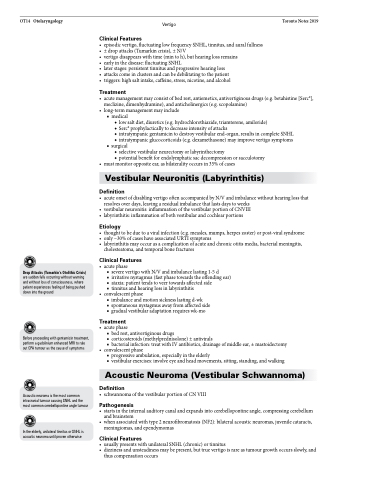Page 1000 - TNFlipTest
P. 1000
OT14 Otolaryngology
Vertigo
Toronto Notes 2019
Drop Attacks (Tumarkin’s Otolithic Crisis)
are sudden falls occurring without warning and without loss of consciousness, where patient experiences feeling of being pushed down into the ground
Before proceeding with gentamicin treatment, perform a gadolinium enhanced MRI to rule out CPA tumour as the cause of symptoms
Acoustic neuroma is the most common intracranial tumour causing SNHL and the most common cerebellopontine angle tumour
In the elderly, unilateral tinnitus or SNHL is acoustic neuroma until proven otherwise
Clinical Features
• episodicvertigo,fluctuatinglowfrequencySNHL,tinnitus,andauralfullness • ±dropattacks(Tumarkincrisis),±N/V
• vertigodisappearswithtime(mintoh),buthearinglossremains
• earlyinthedisease:fluctuatingSNHL
• laterstages:persistenttinnitusandprogressivehearingloss
• attackscomeinclustersandcanbedebilitatingtothepatient • triggers:highsaltintake,caffeine,stress,nicotine,andalcohol
Treatment
• acutemanagementmayconsistofbedrest,antiemetics,antivertiginousdrugs(e.g.betahistine[Serc®], meclizine, dimenhydramine), and anticholinergics (e.g. scopolamine)
• long-termmanagementmayinclude ■ medical
◆ low salt diet, diuretics (e.g. hydrochlorothiazide, triamterene, amiloride)
◆ Serc® prophylactically to decrease intensity of attacks
◆ intratympanic gentamicin to destroy vestibular end-organ, results in complete SNHL ◆ intratympanic glucocorticoids (e.g. dexamethasone) may improve vertigo symptoms
■ surgical
◆ selective vestibular neurectomy or labyrinthectomy
◆ potential benefit for endolymphatic sac decompression or sacculotomy
• mustmonitoroppositeear,asbilateralityoccursin35%ofcases
Vestibular Neuronitis (Labyrinthitis)
Definition
• acuteonsetofdisablingvertigooftenaccompaniedbyN/Vandimbalancewithouthearinglossthat resolves over days, leaving a residual imbalance that lasts days to weeks
• vestibularneuronitis:inflammationofthevestibularportionofCNVIII
• labyrinthitis:inflammationofbothvestibularandcochlearportions
Etiology
• thoughttobeduetoaviralinfection(e.g.measles,mumps,herpeszoster)orpost-viralsyndrome • only~30%ofcaseshaveassociatedURTIsymptoms
• labyrinthitismayoccurasacomplicationofacuteandchronicotitismedia,bacterialmeningitis,
cholesteatoma, and temporal bone fractures
Clinical Features
• acutephase
■ severe vertigo with N/V and imbalance lasting 1-5 d
■ irritative nystagmus (fast phase towards the offending ear) ■ ataxia: patient tends to veer towards affected side
■ tinnitus and hearing loss in labyrinthitis
• convalescentphase
■ imbalance and motion sickness lasting d-wk
■ spontaneous nystagmus away from affected side ■ gradual vestibular adaptation requires wk-mo
Treatment
• acutephase
■ bed rest, antivertiginous drugs
■ corticosteroids (methylprednisolone) ± antivirals
■ bacterial infection: treat with IV antibiotics, drainage of middle ear, ± mastoidectomy
• convalescentphase
■ progressive ambulation, especially in the elderly
■ vestibular exercises: involve eye and head movements, sitting, standing, and walking
Acoustic Neuroma (Vestibular Schwannoma)
Definition
• schwannomaofthevestibularportionofCNVIII
Pathogenesis
• startsintheinternalauditorycanalandexpandsintocerebellopontineangle,compressingcerebellum and brainstem
• whenassociatedwithtype2neurofibromatosis(NF2):bilateralacousticneuromas,juvenilecataracts, meningiomas, and ependymomas
Clinical Features
• usuallypresentswithunilateralSNHL(chronic)ortinnitus
• dizzinessandunsteadinessmaybepresent,buttruevertigoisrareastumourgrowthoccursslowly,and
thus compensation occurs


